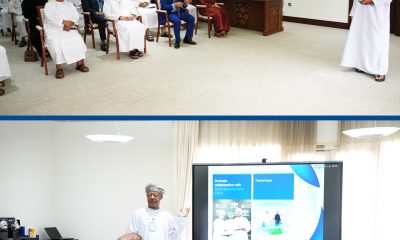Environment
Oman Launches Initiatives to Reduce Carbon Emissions

The Sultanate of Oman has stepped up its game in reducing carbon emissions to achieve the net-zero plan by 2050 through initiatives in the land, sea and air transport sectors, as well as the communications and information technology sectors.
Abdullah Ali Al Busaidi, Director General of Oman Logistics Centre at the Ministry of Transport, Communications and Information Technology and an expert at the Zero Neutrality Team, explained that there is a clear plan for land transport projects in cooperation with the public and private sectors to replace light vehicles with environmentally friendly vehicles.
He pointed to the great leap in the use of electric cars that reached 1,500 vehicles according to the latest statistics, and the number of charging points has reached 120 points in various governorates.
Hydrogen energy is the most suitable solution to reduce emissions from heavy vehicles, said Al Busaidi, who explained that there are challenges in preparing the infrastructure to provide hydrogen in appropriate quantities, but the Sultanate of Oman has currently decided to activate green lanes for trucks.

He added that emissions from the land transport sector amount to 20 per cent of total emissions in all sectors. After adding the air and sea transport sectors, they may amount to 28 per cent of total emissions, according to what was calculated by port operators and local airlines, noted Al Busaidi.
He pointed out that the targets for reducing emissions in the Sultanate of Oman were divided into three stages. In the transportation sector, the reduction rate in 2030 will reach 3 per cent of total emissions, an additional 34 per cent in 2040, and reach 100 per cent by 2050.
He affirmed that the work plans currently being carried out by the Ministry of Transport, Communications and Information Technology on heavy transport are the gradual transition to hydrogen trucks using the dual-combustion truck, as this technology was developed locally by the private sector and a 52 per cent reduction was proven.
As for the emissions of the communications and information technology sector, Al Busaidi said that these emissions are currently based on information centres and communication towers, in light of the country’s expansion in the digital economy and information technology infrastructure.
Work is underway on emissions inventory and reducing them, in a manner that makes Oman keep pace with the world’s plans in this approach.
He stated that there are also initiatives for the maritime transport sector to reduce emissions by converting the facilities used to environmentally friendly ones and converting equipment to electric ones away from fossil fuels, in light of the Sultanate of Oman’s approach to becoming a regional centre for supplying ships with clean energy.
He concluded that the Civil Aviation Authority also has initiatives in air transport, including sustainable fuel projects for aircraft.
-

 Magazines1 month ago
Magazines1 month agoOER – September 2025 Issue
-

 News1 month ago
News1 month agoKitchenomiKs Secures Investment of US$3.2M Led by Jasoor Ventures
-

 Alamaliktistaad Magazines1 month ago
Alamaliktistaad Magazines1 month agoAlam Al Iktisaad – September 2025 Edition
-

 News1 month ago
News1 month agoCent Capital, AI Finance App by ex-AWS Strategist ‘The Beast of Bay Area,’ Launches to End Financial Anxiety, Hits $1M AUM
-

 News1 month ago
News1 month agoOman Inaugurates ‘Hadatha’ – Its All-New Cybersecurity Center
-

 News1 month ago
News1 month agoIEA Expects Global Oil Market to Remain Oversupplied in 2026
-

 Energy1 month ago
Energy1 month agoWLGA Middle East LPG Summit & Expo 2025 to be held at OCEC on November 10 and 11
-

 Banking & Finance1 month ago
Banking & Finance1 month agoOman Arab Bank Highlights Its Ongoing Strategic Initiatives and Future Plans






























